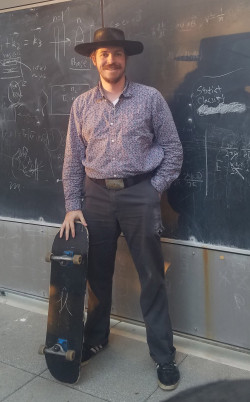A Summer at Berkeley Lab Spurs College Student’s Quantum Computing Aspirations
September 21, 2022
By Keri Troutman
Contact: cscomms@lbl.gov

Donald Ferschweiler
Before this past summer, California State University Long Beach (CSULB) physics undergrad student Donald Ferschweiler had what he describes as “snippets of knowledge” about quantum computing, a subject he found fascinating. But after participating in the Sustainable Research Pathways (SRP) program at Lawrence Berkeley National Laboratory (Berkeley Lab), quantum information science and technology have moved to the top of his list as he delves into graduate school applications.
Ferschweiler, a rising senior, spent two months at the Advanced Quantum Testbed (AQT) at Berkeley Lab, working in collaboration with the Quantum Nanoelectronics Laboratory at the University of California at Berkeley. AQT is a state-of-the-art collaboratory research lab funded by the U.S. Department of Energy Office of Science. The lab operates an open-access experimental testbed based on superconducting quantum hardware designed for cutting-edge R&D and research collaborations. The Quantum Nanoelectronics Laboratory is focused on investigating the quantum coherence of various condensed matter systems. His supervisor was Brian Marinelli, a UC Berkeley graduate student affiliated with QNL and the AQT.
Ferschweiler worked mainly on cross-entropy benchmarking (XEB) of superconducting qubits, a process that uses the random quantum circuits to obtain probability distributions containing information about qubit states, which can be used to ascertain things like the gate fidelity of the underlying hardware, with the goal of characterizing unwanted interactions between adjacent qubits. There are other methods of error characterization, such as quantum process tomography (QPT), cycle benchmarking (CB), and random benchmarking (RB), “but XEB seems to the best for this work because it gives more information than CB or RB, which don’t give us the statistical distributions XEB does, and it costs less computationally than QPT which requires performing enough measurements to fully reconstruct the final state(s) of the qubit(s),” said Ferschweiler. XEB is not commonly used in this manner, but a team of AQT and QNL researchers hope to find XEB to be a useful tool for characterizing cross-talk between superconducting qubits, he added.
“It was amazing to me to see the qubits ‘on the other end of the wire’ respond to the code we’d write,” said Ferschweiler. “I always think it’s neat when there’s some type of physical result to the code I wrote, whether that’s dragging a slider around a screen and seeing the signal getting nulled out or writing some code, sending it off, and getting some results a bit later from the quantum computer saying ‘here’s the result of your work.’”
When he was taking introductory quantum computing courses in college, “it just seemed magical to me, and it still does,” he added. “It is a whole new world and seems special in a way.”
Ferschweiler has been particularly interested in seeing the way statistics are used so broadly in quantum computing. “The impression I had was that quantum computers are very analog critters, whereas classical computing feels more digital,” he said. “In quantum computing we have the bloch sphere, and the qubit can be rotating all around there and when we measure it we get digital results, which we can then use to infer some of the analog properties that are going on behind the scenes; I thought that was really interesting, that we can infer different things based on probability distributions.”
Ferschweiler said he first became interested in physics at a young age when, after sharing his plans to combine lasers and magnifying glasses, a high school student told him he should study physics when he was older to learn how light works. The idea stuck, and although Ferschweiler started off as a mechanical engineering major at Grand Canyon University in Arizona and later at Rio Hondo College in Whittier, CA, he eventually came back to physics.
His time at Berkeley Lab this year was also the result of advice from a mentor; before he transferred to CSULB, one of his professors told him about the SRP program and he was intrigued. SRP was established in 2015 through a partnership between Berkeley Lab and the Sustainable Horizons Institute and has as its mission connecting scientists from underrepresented groups with scientists at Berkeley Lab to encourage the formation of ongoing research collaborations.
To watch Ferschweiler’s virtual poster presentation about his research at Berkeley Lab this summer, visit this link.
About Computing Sciences at Berkeley Lab
High performance computing plays a critical role in scientific discovery. Researchers increasingly rely on advances in computer science, mathematics, computational science, data science, and large-scale computing and networking to increase our understanding of ourselves, our planet, and our universe. Berkeley Lab’s Computing Sciences Area researches, develops, and deploys new foundations, tools, and technologies to meet these needs and to advance research across a broad range of scientific disciplines.







 Instagram
Instagram YouTube
YouTube